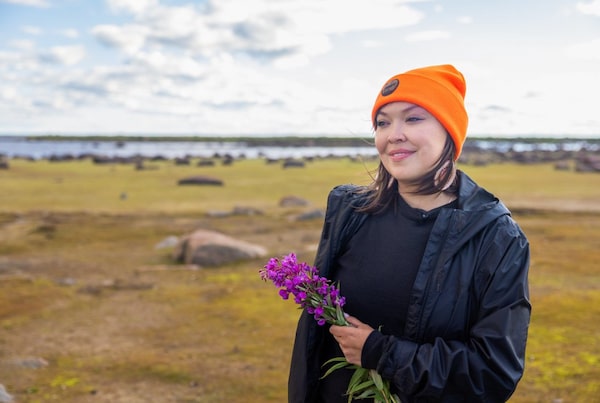
Stephanie Thorassie, executive director of the Seal River Watershed Alliance.Supplied
A coalition of four First Nations has reached an agreement with the federal and provincial governments to establish the massive parcel of land surrounding the Seal River in northern Manitoba – one of the world’s largest remaining ecologically intact watersheds – as an Indigenous-protected area.
Chiefs of the Sayisi Dene First Nation, O-Pipon-Na-Piwin Cree Nation, Northlands Denesuline First Nation and Barren Lands First Nation signed the landmark accord on Thursday, along with federal Environment Minister Steven Guilbeault and Manitoba Premier Wab Kinew, at a hotel on an urban reserve in Winnipeg.
They agreed to not only protect the land, but also to determine how to foster it as a self-sustaining park that would welcome ecotourists from across the country and beyond.
In an interview with The Globe and Mail ahead of announcing the deal, Stephanie Thorassie, executive director of the Seal River Watershed Alliance, which is the coalition formed by the First Nations in 2019, described the decades of unheard pleas and difficult work that led up to it.
“Truly, in every way possible, this is a historic moment that would bring tears to my Dene ancestors and everyone this land has belonged to for time immemorial,” she said.
The Seal River is a pristine watercourse that travels eastward from Shethanei Lake – passing through unique eskers, boreal forests, boulder fields, stands of black spruce and arctic tundra – to reach an estuary at Hudson Bay. The watershed spans about 50,000 square kilometres, roughly the size of Costa Rica or Nova Scotia.
A variety of animals thrive in the area, such as caribou, moose, wolves, fox, black bears, numerous waterfowl and songbirds. Harbour seals, whom the river is named after, roam upstream despite normally being saltwater mammals, while polar bears are found paddling near the Bay. The river’s estuary is also a calving and feeding ground for thousands of beluga whales, one of the world’s largest concentrations of the sociable creatures.
“The river has never been touched by modern-day miners or industrial developers,” said Lianna Anderson, a land guardian for the Seal River watershed from O-Pipon-Na-Piwin Cree Nation.
Thursday’s agreement sets in motion a formal plan for the First Nations, federal officials and the province to work together over the coming months in designating the watershed as an Indigenous protected and conserved area.
Commonly called IPCAs, such designations, where Indigenous peoples play the primary role of caretaking, have been called crucial by organizations such as the World Wildlife Fund and the United Nations Environment Programme. They have been gradually emerging in Canada, especially in British Columbia.
Some portions of the Seal River watershed are currently protected by three Manitoba wilderness parks and an ecological reserve. However, the new agreement is based on the belief that protecting the entire watershed as an IPCA would ensure its long-term well-being and longevity. It would also inch the federal government closer to its goal of protecting 30 per cent of Canada’s lands and waters by 2030.
Mr. Guilbeault said Ottawa began working on the Seal River initiative with the First Nations and Manitoba’s former Progressive Conservative government in late 2022, when the parties met at the COP15 conference in Montreal. “But progress unfortunately stalled for months, until Premier Kinew decided to withdraw the land from future mining,” he said.
The federal government is promising approximately $1.5-million in funding for the next portion of the research needed to ascertain the feasibility of the Seal River’s protection plan and whether it can become an environmentally-responsible national park.
“Ultimately, we want our people to be self-sustaining. That really is why we’re looking at tourism,” Ms. Thorassie said. “Often, our land users and guardians are on social assistance, so we want to create jobs for people that are here on the land every day.”
Early European colonizers of the Hudson Bay region did not find the Seal River of much use, but Dene peoples had called that land their home for more than 7,000 years. There were attempts in the 1940s to set up mining camps near the mouth of the river, though those sites were short-lived.
Beginning in 1956, Sayisi Dene were forcibly removed from within the Seal River watershed and relocated to camps at Churchill, a town close to the Manitoba-Nunavut border. This led to extreme poverty and violence. Some children were neglected or abused; others were sent to residential schools. Nearly a third of the Sayisi Dene community there died in the following years.
The government of Canada formally apologized in 2016 for the relocation and the trauma caused by it. “This shameful chapter in Canada’s history is one that stemmed from the pervasive legacy of colonialism – a legacy of disrespect, lack of understanding and unwillingness to listen,” Carolyn Bennett, then-minister of Indigenous and northern affairs, had said.
Since the 1970s, Sayisi Dene leaders and community members took it upon themselves to return to the watershed, settling near Tadoule Lake. Over the years, the communities restored their connection to the land and took responsibility for the plants, animals and water there. “We want to keep taking care of it,” Ms. Anderson said.
At the agreement’s signing, Mr. Kinew told The Globe, “When we’re looking at growing the economy in Manitoba, it’s about making choices.”
He said that while mineral development and mining may be the right fit in some parts of the province, “ecotourism that we’ve seen grow in Churchill” is the right option for others, such as the Seal River.
“Not only will this help market Canada abroad, but it will also help bring opportunity to the region,” he said.